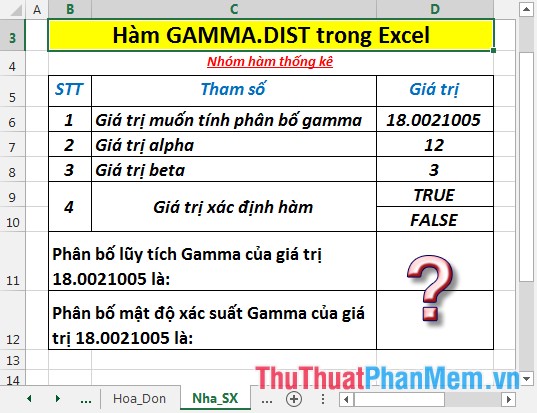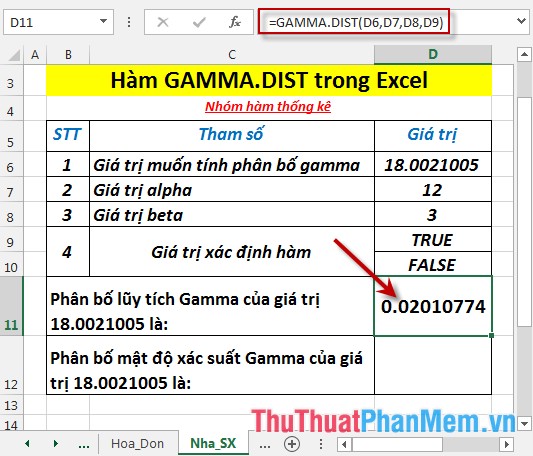GAMMA.DIST function - The function returns the gamma distribution in Excel
The following article introduces you to the GAMMA.DIST function - one of the functions in the statistical function group is very popular in Excel.

Description: The function returns the gamma distribution , using this function to study the skewed distribution variables . Support functions from Excel 2010 onwards.
Syntax: GAMMA.DIST (x, alpha, beta, cumulative)
Inside:
- x: The value you want to calculate the gamma distribution .
- alpha: The parameter value to the distribution .
- beta: Value The parameter value to the distribution , if beta = 1 -> function returns the standard gamma distribution .
- cumulative: Logic values that define the function format include:
+ cumulative = True -> Returns the cumulative distribution function.
+ cumulative = False -> Returns the probability density function.
Attention:
- If one of the function's x, alpha, and beta arguments is not a number form -> the function returns the #VALUE! Error value
- If x <0 or alpha ≤ 0 or beta ≤ 0 -> the function returns the #NUM! Error value
- The equation for calculating the gamma probability density function is:
[fleft ({x, alpha} right) = frac {1} {{{beta ^ alpha} Gamma left (alpha right)}} {x ^ {alpha - 1}} {e ^ {- frac {N} {beta }}}]
- The equation for calculating the standard gamma probability density function is:
[fleft ({x, alpha} right) = frac {{{x ^ {alpha - 1}} {e ^ {- N}}}} {{Gamma left (alpha right)}}]
- When alpha = 1 -> function returns exponential distribution with:
[alpha = frac {1} {beta}]
- For n positive integers, if alpha = n / 2 , beta = 2 , cumulative = true -> the function returns the value (1 - CHISQ.DIST.RT (x)) with n degrees of freedom.
- If alpha is a positive integer, the function GAMMA.DIST is called the Erlang distribution .
For example:
Find the GAMMA probability distribution and density in the data table below:

- Calculate the cumulative gamma distribution . In a cell to calculate, enter the formula : = GAMMA.DIST (D6, D7, D8, D9)

- Press Enter -> GAMMA cumulative distribution is:

- Calculate the gamma probability density distribution . In a cell to calculate, enter the formula: = GAMMA.DIST (D6, D7, D8, D10)

- Press Enter -> Gamma probability density is:

Above are instructions and some specific examples when using the GAMMA.DIST function in Excel.
Good luck!
You should read it
- POISSON.DIST function - The function returns the Poisson distribution in Excel
- BETA.DIST function - The function returns the Beta distribution in Excel
- HYPGEOM.DIST - The function returns the hyperbolic distribution in Excel
- F.DIST - The function returns the probability distribution F in Excel
- T.DIST.RT - The function returns the Student's t-distribution on the right in Excel
- GAMMALN.PRECISE function - The function returns the natural logarithm of the gamma function, Γ (x) in Excel
- CHISQ.DIST - Function returns the distribution when squared in Excel
- LOGNORM.DIST - Function returns the logarithmic distribution of x in Excel
May be interested
- PHI function - The function returns the value of the density function for a normal distribution in Excel
 phi function: the function returns the value of the density function for a standard normal distribution. support functions from excel 2013 onwards. syntax: phi (x)
phi function: the function returns the value of the density function for a standard normal distribution. support functions from excel 2013 onwards. syntax: phi (x) - LOGNORM.INV function - The function returns the inverse of the logarithmic distribution of x in Excel
 lognorm.inv: the function returns the inverse of the logarithmic distribution of x. where ln (x) is usually distributed with parameter mean and standard deviation. use functions to analyze logarithmic change data. support function from excel 2 version
lognorm.inv: the function returns the inverse of the logarithmic distribution of x. where ln (x) is usually distributed with parameter mean and standard deviation. use functions to analyze logarithmic change data. support function from excel 2 version - T.INV function - The function returns the inverse value of the Student t distribution in Excel
 t.inv: the function returns the inverse value of the student t-distribution. support functions from excel 2010 onwards. syntax: t.inv (probability, deg_freedom)
t.inv: the function returns the inverse value of the student t-distribution. support functions from excel 2010 onwards. syntax: t.inv (probability, deg_freedom) - T.DIST.RT - The function returns the Student's t-distribution on the right in Excel
 t.dist.rt: the function returns the student's t-distribution on the right. functions used in testing the hypothesis of small numbers of data sets. support functions from excel 2010 onwards. syntax: t.dist.rt (x, deg_freedom)
t.dist.rt: the function returns the student's t-distribution on the right. functions used in testing the hypothesis of small numbers of data sets. support functions from excel 2010 onwards. syntax: t.dist.rt (x, deg_freedom) - F.DIST - The function returns the probability distribution F in Excel
 f.dist function: the function returns the probability distribution f. the function supports the version from excel 2010. syntax: f.dist (x, deg_freedom1, deg_freedom2, cumulative)
f.dist function: the function returns the probability distribution f. the function supports the version from excel 2010. syntax: f.dist (x, deg_freedom1, deg_freedom2, cumulative) - HYPGEOM.DIST - The function returns the hyperbolic distribution in Excel
 hypgeom.dist: the function returns the hyperinfection distribution, using this function for problems with finite sets of vowismooix observations whether or not they are successful. syntax: hypgeom.dist (sample_s, number_sample, population_s, number_pop, cumulative)
hypgeom.dist: the function returns the hyperinfection distribution, using this function for problems with finite sets of vowismooix observations whether or not they are successful. syntax: hypgeom.dist (sample_s, number_sample, population_s, number_pop, cumulative) - F.INV function - The function returns the inverse of the probability distribution F in Excel
 f.inv function: the function returns the inverse of the probability distribution f. support function from the excel 2010 version. syntax: f.inv (probability, deg_freedom1, deg_freedom2)
f.inv function: the function returns the inverse of the probability distribution f. support function from the excel 2010 version. syntax: f.inv (probability, deg_freedom1, deg_freedom2) - F.INV.RT function - The function returns the right-inverse head value of the probability distribution F in Excel
 f.inv.rt function: the function returns the inverse of the right probability distribution f. support functions from the excel 2010 version. syntax: f.inv.rt (probability, deg_freedom1, deg_freedom2)
f.inv.rt function: the function returns the inverse of the right probability distribution f. support functions from the excel 2010 version. syntax: f.inv.rt (probability, deg_freedom1, deg_freedom2) - CHISQ.DIST - Function returns the distribution when squared in Excel
 chisq.dist: the function returns the distribution when squared, and this value is often used to understand variations as a percentage of the samples. support function from excel 2010 version. syntax: chisq.dist (x, deg_freedom, cumulative)
chisq.dist: the function returns the distribution when squared, and this value is often used to understand variations as a percentage of the samples. support function from excel 2010 version. syntax: chisq.dist (x, deg_freedom, cumulative) - LOGNORM.DIST - Function returns the logarithmic distribution of x in Excel
 lognorm.dist: the function returns the logarithmic distribution of x. where ln (x) is usually distributed with parameter mean and standard deviation. support functions from excel 2010 onwards. syntax: lognorm.dist (x, mean, standard_dev, cumulative)
lognorm.dist: the function returns the logarithmic distribution of x. where ln (x) is usually distributed with parameter mean and standard deviation. support functions from excel 2010 onwards. syntax: lognorm.dist (x, mean, standard_dev, cumulative)










 SECOND function - The function returns the second part of a time value in Excel
SECOND function - The function returns the second part of a time value in Excel TIME function - Function returns decimal numbers for a specific time value in Excel
TIME function - Function returns decimal numbers for a specific time value in Excel TIMEVALUE function - The function returns the decimal number of time expressed as a text string in Excel
TIMEVALUE function - The function returns the decimal number of time expressed as a text string in Excel AVEDEV function
AVEDEV function AVERAGE function - The function returns the average of the arguments in Excel
AVERAGE function - The function returns the average of the arguments in Excel AVERAGEA function - The function returns the average of the arguments including numeric, text, and logical values in Excel
AVERAGEA function - The function returns the average of the arguments including numeric, text, and logical values in Excel